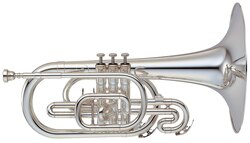Mellophone
 |
|
| Other names | en: Mellophonium, tenor cor, fr: cor alto, de: Altkorno, Alt-Corno, it: genis corno |
|---|---|
| Classification | |
| Playing range | |
| in F: sounds one fifth lower than written | |
| Related instruments | |
The mellophone is a three-valved brass instrument pitched in the key of F or E♭. It has a conical bore, like that of the euphonium and flugelhorn. The mellophone is used as the middle-voiced brass instrument in marching bands and drum and bugle corps in place of French horns, and can also be used to play French horn parts in concert bands and orchestras.
These instruments are used instead of French horns for marching because their bells face forward instead of to the back (or to the side), as dissipation of the sound becomes a concern in the open-air environment of marching. Tuning is done solely by adjusting the piping, instead of adjusting both piping and hand position as on the French horn. Fingerings for the mellophone are the same as fingerings for the trumpet, alto (tenor) horn, and most valved brass instruments. Owing to its use primarily outside of concert music, there is little solo literature for the mellophone, other than that used within drum and bugle corps.
The present-day mellophone has three valves, operated with the right hand. Mellophone fingering is the same as the trumpet and is typically pitched lower, in the key of F or E♭. The overtone series of the F mellophone is an octave above that of the F horn. The tubing length of a mellophone is the same as that of the F-alto (high) single horn or the F-alto (high) branch of a triple horn or double-descant horn.
The direction of the bell as well as the much-reduced amount of tubing (compared to a French horn) make the mellophone look like a large trumpet. The mellophone uses the same mouthpiece as the alto (tenor) horn, which is in-between the size of a trombone and trumpet mouthpiece. This mouthpiece usually has a deep cup, like that of the flugelhorn, and has a wider inner diameter than a trumpet mouthpiece. These mouthpieces give the mellophone a dark, round sound. Some trumpet players who double on mellophone use a trumpet-style parabolic ("cup") mouthpiece on the instrument, resulting in a much brighter, more trumpet-like sound. Horn players doubling on mellophone often use a smaller, lighter, conical ("funnel") mouthpiece, as used on French horns, with an adapter to allow them to fit in the larger-bore lead pipe of the mellophone. This style mouthpiece gives the instrument a warmer sound than using a trumpet mouthpiece, and allows French horn players to play the mellophone without changing their embouchure between the two instruments.
...
Wikipedia

